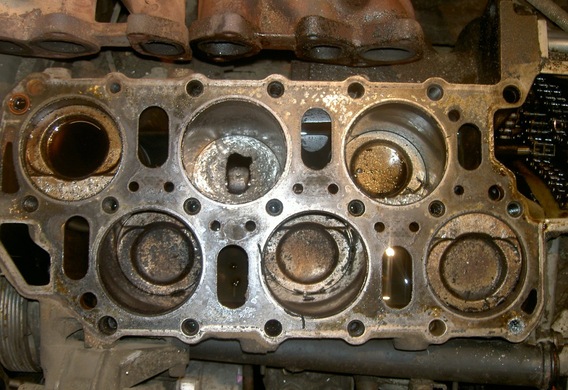
Name of VR
Contrary to the logical assumption, the letter V in the name of the assembly is not related to the V-shaped engines. VR is an abbreviation composed of two German words "Verkürzt Reihenmotor", which means "short-term engine" in translation.
History of VR engine creation
In our days, the engines with a runaway build are almost unopposed to the VVW motors of the German Volkswagen. Six-cylinder VW engines appeared in the late 1980s, and the company is still successfully installing the engines of this assembly into its modern models.
The development of Volkswagen was based on the V4 four-cylinder design that was widely used in Lancia and Ford cars. Surprisingly, the third engine manufacturer of this assembly was Soviet, then Ukrainian Melitopol Motor Plant. The V4 engines were installed in Zaporozhtzi and the small SUVs made by Zaporozhtzi small SUVs.
VW VR6, developed during the period when VW Chairman was Ferdinand Pee, was first presented in Europe in 1991. VR6 began to install in the Passat and Corado models.
In the American model Corr adero, an engine of 2.8 liters was used. Later, the license for the production of these engines was purchased by the Mercedes company, which subsequently launched its own model M104.900.
Developers of Volkswagen Group went further and, having removed one cylinder, created the VR5 engine. This engine was placed in the Passat of the 1997 model year, and Golf 1999.
Advantages of VR6 engines
Originally, by creating an engine with a pompous build, the Volkswagen company was designed to create a six-cylinder engine with a short block. The normal V-shaped engine did not meet the needs of the developers because, thanks to a large cylinder, the engine was too wide, making it difficult to use the engine in vehicles with a transverse position of the powertrain. After creating a straight-off engine, the company has been given a unique opportunity to install a six-cylinder engine into a subspace of the already existing models of the vehicles with a transverse position of the engine without major changes.
VR6 engine-specific features
Unlike V6, which has a symmetrical construction relative to the shaft, VR6 is built asymmetrically. The intake manifold is installed on one side of the engine and the exhaust manifold is on the other side.
With all 6 cylinders in one short block, VW VR6 is much lighter than any V6 of the same volume. The VR6 unit has been turned into a checkerboard, not a single line, cylinder.
VW VV VR6 is located at a very low distance from each other, but at a small angle, allowing the common valve cover to be left behind. There was no room for it in the head of the block.
The output was found-the SOHC system has been enhanced to take into account a number of features of the DOHC system.
For this, it was necessary to position 4 valves on each cylinder in a limited space above the piston. At the same time, it was necessary to establish a mechanism of transmission of valves valves strictly above them. Otherwise, opening and closing of the valves would be delayed, which would inevitably result in increased fuel consumption and maximum turnover limit.
By applying the SOHC build, the company refused to use the system of changing phases of the gas distribution, which also saved the space.
During the development process there were other problems for which engineers had to find new ways. For example, it was found that the VR6 structure with 6 cylinder blocks and one HBCD implies different lengths of inlet and outlet ports. According to the engine theory, this means that the cylinders will produce different power at a certain speed of the wheel shaft. The solution was found in the installation of a specially developed Pentile Indoor collector, setup of opening and closing of valves and unusual division of the exhaust manifold into two patrons (each of the tubes is served by 3 cylinders at once).
Benefits and deficiencies of the VR6 engine
From the unusual arrangement of cylinders, the balance of the "true" six-cylinder engine has no remaining trace, so it has taken additional measures to balance by the installation of additional rubble. This feature, along with an unusual design of the GRM, makes it much more expensive in the production of an aggregate. However, the ability to make a six-cylinder engine is compact in this case more important than lowering the cost price.
Further development of VR6 engines
As the practice has shown, VW has managed to overcome most of the structural limitations of the engine. In particular, in later VR6 engines, the composition of the DOHC gas distribution mechanism has been implemented, resulting in an increase in the engine capacity without a significant increase in fuel consumption.
The first mass VR6 volume 2.8/174 h.sc after a series of structural changes turned into an engine of 2.9 litres volume with a capacity of 190, and later and 204 hp.
Other engines based on a bold build
Volkswagen is currently manufacturing the W8 engine, which represents the two VR6 motors, which have been cut off in two cylinders.
There is a more impressive aggregate-W12, in which two VR6 motors installed at an angle of 72 ° coexist in one unit. Later, as the development of this building, R32 and R36 engines, volume 3.2 l and 3.6 l were introduced, respectively.
The mansion is equipped with VW powertrain W16 Bugatti Veyron. This unique engine is composed of four engines of type VR, which rotate one knee.









